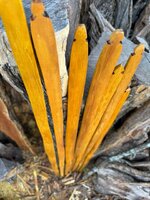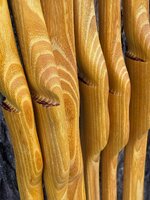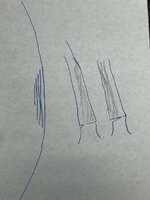You are using an out of date browser. It may not display this or other websites correctly.
You should upgrade or use an alternative browser.
You should upgrade or use an alternative browser.
Understanding wood fiber -theory.
- Thread starter davidwyby
- Start date
- Replies 64
- Views 4K
More options
Who Replied?- Thread Starter Thread Starter
- #29
Thought it interesting how the tension side is a continuous run. I’m sure if you don’t make it that way, or you pull it the other way, it explodes. Like runout in an axe handle.
I’d like to try Osage for a handle. I have some I cut down, but I’m afraid it might have died and been desert dried for too many decades.
I’d like to try Osage for a handle. I have some I cut down, but I’m afraid it might have died and been desert dried for too many decades.
Kaveman
Treehouser
I've been invited to climb a couple Osage, when I do, I'll save you anything big enough for hanging and axe.
- Thread Starter Thread Starter
- #32
Re: bending vs pulling hinge, I had a bulb on that one too.
Buckin went east and Humboldted some hardwoods. Fiber pull. The more closed Humboldt pulls fiber, where as an open or vertical hinge face bends and breaks the fibers before it closes.
Buckin went east and Humboldted some hardwoods. Fiber pull. The more closed Humboldt pulls fiber, where as an open or vertical hinge face bends and breaks the fibers before it closes.
Burnham
Woods walker
I think that is true for either the Humbolt or the conventional face. No other way it could be.
stikine
Treehouser
Fiber pull has more to do with hinge thickness.
SeanKroll
Treehouser
I've been invited to climb a couple Osage, when I do, I'll save you anything big enough for hanging and axe.
???Light bulb on why the deep face prevents barberchair. Moves the transition or division point of rigid log.
View attachment 147818
Say more.
SeanKroll
Treehouser
I think there is a component of having the pith in the hinge.
"angiosperms (hardwoods) and gymnosperms (softwoods) build compensatory wood differently. Angiosperms produce tension wood on the upper side of a leaning stem, which contracts to pull it upright, while gymnosperms produce compression wood on the lower side to push it upright. These two types of reaction wood represent two different mechanisms for responding to gravity. "
With compensatory growth in an alder (local BC-prone species), there will be more tension wood, putting the pith close or within the hinge when face-cut shallowly.
If an alder is face-cut deeply, the pith will be in the front-side of the hinge and holding wood.
"angiosperms (hardwoods) and gymnosperms (softwoods) build compensatory wood differently. Angiosperms produce tension wood on the upper side of a leaning stem, which contracts to pull it upright, while gymnosperms produce compression wood on the lower side to push it upright. These two types of reaction wood represent two different mechanisms for responding to gravity. "
With compensatory growth in an alder (local BC-prone species), there will be more tension wood, putting the pith close or within the hinge when face-cut shallowly.
If an alder is face-cut deeply, the pith will be in the front-side of the hinge and holding wood.
stikine
Treehouser
As a general guideline we would teach that when you are constructing your hinge it should be a minimum length of 80% of the dbh and a maximum hinge thickness of 10% dbh. We called it the 80 plus /10 minus guideline. It's a good starting point for teaching new sawyers because it puts some measurable metrics when evaluating how they are doing.???
Say more.
There are obviously situations where you need to deviate from the "guideline" ... like putting in a deep undercut on a short stob for instance or dealing with side lean.
If you are getting fiber pull longer than 4 inches you probably should thin your hinge so it can bend easier. That's when local species knowledge comes in handy. Your Doug fir for instance should probably be a bit less than 10%.
Sorry Sean, I thought your question marks were directed at me, my bad.
Last edited:
Burnham
Woods walker
Kaveman
Treehouser
Osage Orange, a very interesting species.???
Say more.
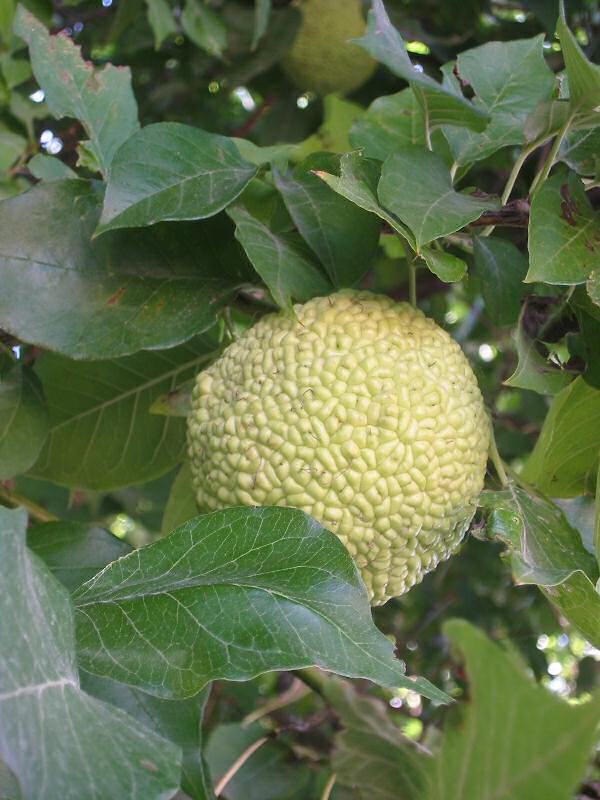
Maclura pomifera - Wikipedia
One of the friends I've made here locally has the biggest and nicest I've seen in Mariposa County during my year of exploring trees here. I've been granted free access to the ranch, I just haven't taken advantage yet. He's a fine fellow, just queer as a two dollar bill and quite infatuated with me.
SeanKroll
Treehouser
I like that nugget for teaching : "The 80+/10- rule"
SeanKroll
Treehouser
I'm still unclear what is being visually represented here.Light bulb on why the deep face prevents barberchair. Moves the transition or division point of rigid log.
View attachment 147818
- Thread Starter Thread Starter
- #42
@SeanKroll I should have continued my trees further up.Light bulb on why the deep face prevents barberchair. Moves the transition or division point of rigid log.
View attachment 147818
A rare occurrence, having trouble articulating my thoughts on it. Almost more like a gut feeling. Something about the rigid part of a bow where the handle is, and how if one pulled it backwards it would probably break (split between rings).
The shaded areas in my drawing are the rigid part. Somehow it answered the question of why a deep face cancels barberchair. If the rigid section is to the rear, the hinge becomes a fulcrum and either it being too thick or the face closing too early causes a split.
If we face cut deep, the rigid section is now in the front and the hinge simply bends. If the face closed, it might still chair, but somehow it seems quite unlikely. Seems like it would either stop or pull/break the hinge. Seems like it might be easy to test with a stick and handsaw.
- Thread Starter Thread Starter
- #43
Seems very relevant to another rabbit trail: back cut (and wedges) first.I think there is a component of having the pith in the hinge.
"angiosperms (hardwoods) and gymnosperms (softwoods) build compensatory wood differently. Angiosperms produce tension wood on the upper side of a leaning stem, which contracts to pull it upright, while gymnosperms produce compression wood on the lower side to push it upright. These two types of reaction wood represent two different mechanisms for responding to gravity. "
With compensatory growth in an alder (local BC-prone species), there will be more tension wood, putting the pith close or within the hinge when face-cut shallowly.
If an alder is face-cut deeply, the pith will be in the front-side of the hinge and holding wood.
SeanKroll
Treehouser
IDK that the order would help.Seems very relevant to another rabbit trail: back cut (and wedges) first.
No wedges needed with a head leaner.
- Thread Starter Thread Starter
- #45
I think back cut first is usually used for back leaners. It would seem you would want to make a pretty deep back cut first, working the wedges in, so as not to lose any lift or pick up any more back lean. More leverage before and after the face is in.IDK that the order would help.
No wedges needed with a head leaner.
Last edited:
- Thread Starter Thread Starter
- #46
If Angio hold themselves up with tension, it would explain their increased propensity to ‘chair.I think there is a component of having the pith in the hinge.
"angiosperms (hardwoods) and gymnosperms (softwoods) build compensatory wood differently. Angiosperms produce tension wood on the upper side of a leaning stem, which contracts to pull it upright, while gymnosperms produce compression wood on the lower side to push it upright. These two types of reaction wood represent two different mechanisms for responding to gravity. "
With compensatory growth in an alder (local BC-prone species), there will be more tension wood, putting the pith close or within the hinge when face-cut shallowly.
If an alder is face-cut deeply, the pith will be in the front-side of the hinge and holding wood.
Getting to the pith would help, the rings are 90° to the cuts there and less likely to separate.
SeanKroll
Treehouser
I missed a change in direction from BC-propensity to back leaners.I think back cut first is usually used for back leaners. It would seem you would want to make a pretty deep back cut first, working the wedges in, so as not to lose any lift or pick up any more back lean. More leverage before and after the face is in.
Working on a small screen and two weeks of being very tired.
- Thread Starter Thread Starter
- #48
I don’t think you missed it, I think I did😆I missed a change in direction from BC-propensity to back leaners.
Working on a small screen and two weeks of being very tired.
SeanKroll
Treehouser
The pith is, from my armchair, the worst to have within/ right near the hinge.If Angio hold themselves up with tension, it would explain their increased propensity to ‘chair.
Getting to the pith would help, the rings are 90° to the cuts there and less likely to separate.
Bigleaf maples can be heard crack and pop very audibly at a significant distance. My guess is that happens as I approach the pith. I can feel and hear it pop over the gas saw.
When chunking short (~6-10') qmaple logs with a lean, I cut the holding-wood into a square in the middle of the cross-section, then cut tension to compression. The log slides off. No facecut on the underside with risk of an unseen dutchman, nor tipping leverage on a hinge. Definitely no pith in a hinge.
- Thread Starter Thread Starter
- #50
True. Sawmillers say to avoid the pith as it splits and quite often trees I cut are already cracked there. So to avoid a chair we need to get deeper in past the pith. That’s the tricky part. I have an idea for bore cutting out the face and leaving a collapsible kickstand in the front, but it’s very gimmicky and at that point one would be better off to just bore and trigger.The pith is, from my armchair, the worst to have within/ right near the hinge.
Bigleaf maples can be heard crack and pop very audibly at a significant distance. My guess is that happens as I approach the pith. I can feel and hear it pop over the gas saw.
When chunking short (~6-10') qmaple logs with a lean, I cut the holding-wood into a square in the middle of the cross-section, then cut tension to compression. The log slides off. No facecut on the underside with risk of an unseen dutchman, nor tipping leverage on a hinge. Definitely no pith in a hinge.
